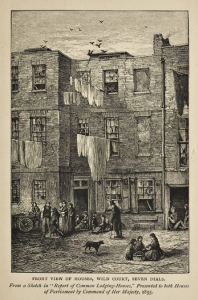St. Giles District gained and lost a large percentage of its population at the beginning and end of the 19th century respectively. From 1801 to 1811, the population made a huge leap from 36,502 people to 48, 536 people, a dramatic increase of about 33%. After this initial jump, the population change of St. Giles slows down to near-zero around 1831, changing little for 4 decades. Between 1871 and 1881 this suddenly changes as the population dramatically declines to around 45,000, a 16% decrease.
These changes can only be understood in the context of the rest of London and population density. St. Giles District remained in the highest category for population density throughout the 19th century. It’s a small district, but its central location and short distance from the city of London likely made it attractive for incomers from the countryside. Moreover, at the beginning of the 19th century, those areas closer to London tended to be more developed, allowing for a higher concentration of people to live and find work there. As the century progressed, however, more areas started to be developed. Given that the population density of St. Giles was so high, it’s likely that its denizens decided to move away from this area into the less occupied areas now more available to them.
This trend is mirrored in the different metropolitan districts of London. The categories on the map indicating population density are colored from light to dark. Lighter colors represent a smaller population density, while darker colors represent a larger population density. Visually, the interactive map displays an inverse relationship between the darkness of the colors for central districts and time. This shows that as time progressed, many people moved from the center of London to the This creates a stronger argument that more occupations may have become available in the less populated districts as they developed. Thus, living in areas with a smaller population density may have allowed for more comfortable living and better job security due to a decrease in competition, creating an incentive for people to leave the center of London.
The argument for an increase in the development of areas further away from the center of London is further supported by observing the distribution of institutions over time. At the beginning of the century, most institutions are located in the center of London, but by 1890 the quantity of institutions grew and the institutions themselves became more evenly distributed, creating opportunities for more people to live in areas of smaller population density.

